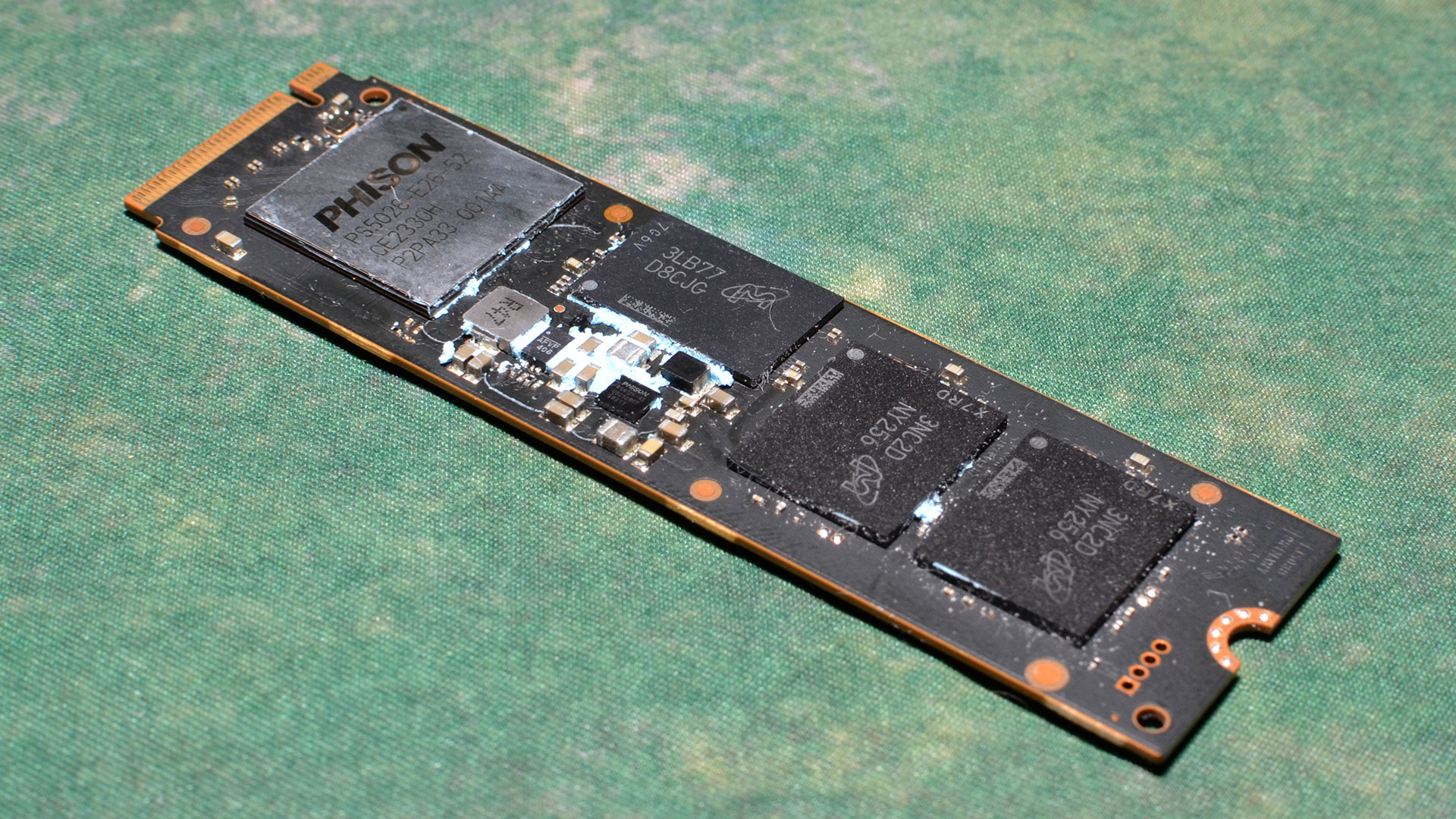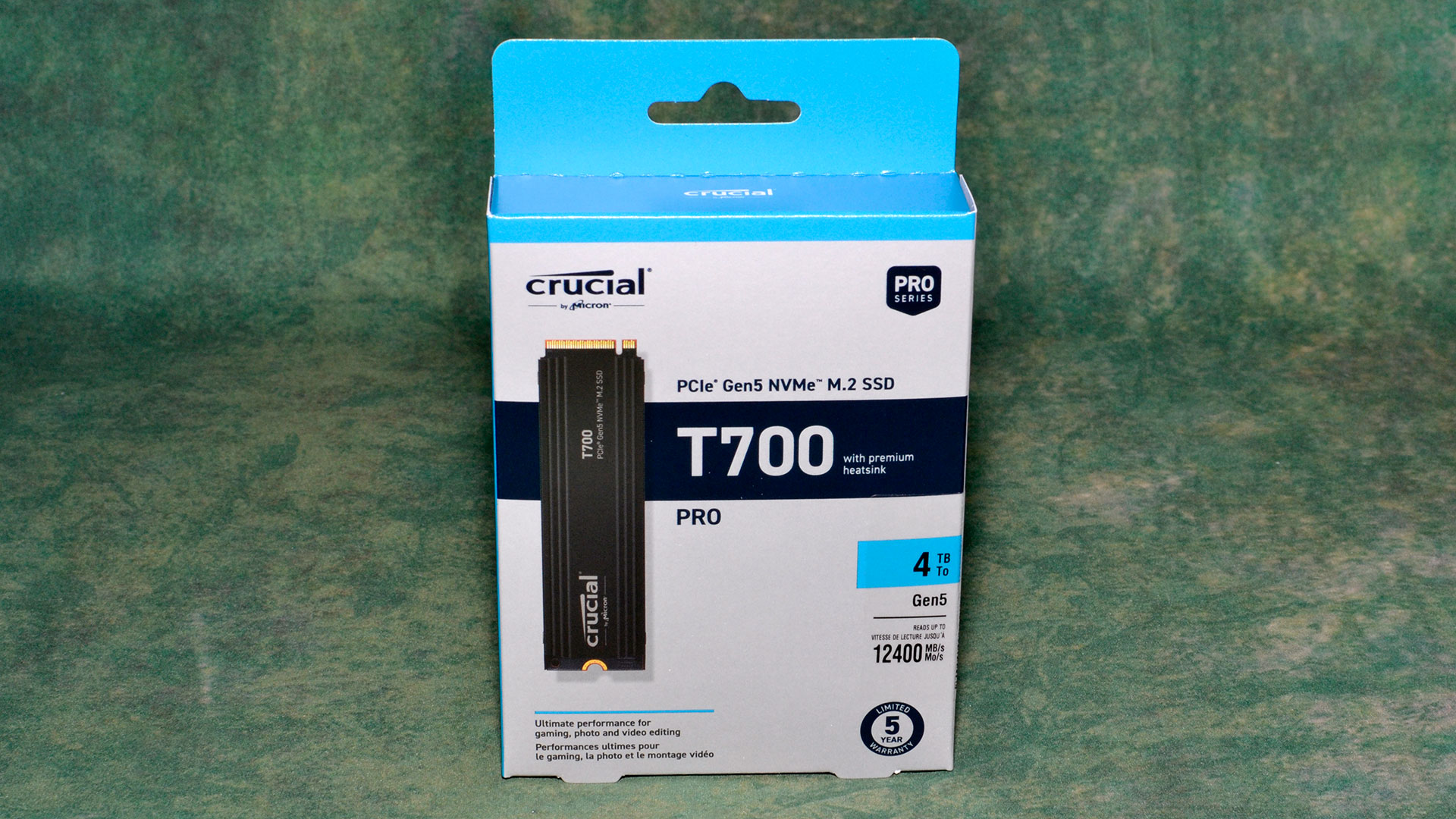Tom's Hardware Verdict
If you want the fastest, most capacious SSD on the market, as of today that's the 4TB Crucial T700. It hits all the right marks, as long as you can swallow its high power consumption and price.
Pros
- +
4TB of high performance storage
- +
Good all-around and sustained performance
- +
Optional heatsink
Cons
- -
High power consumption and heat generation
- -
Expensive
Why you can trust Tom's Hardware
If you’re going to go all out with a high-end, PCIe 5.0 SSD, why not also get as much capacity as possible? Crucial has your answer, with its 4TB T700 ready to go — with or without a heatsink. We previewed and then reviewed the T700 at 2TB and found it to be the fastest drive we’d ever tested, and it ranks among the best SSDs currently available. Even after looking at many more PCIe 5.0 drives since, the T700 still sits near the top of our SSD benchmarks hierarchy. But 2TB is so 2022, and we've longed for a 4TB PCIe 5.0 drive — that’s the meaty capacity we really want, and it should perform better as well.
Does the T700 4TB deliver? We’re happy to say that it pushed the envelope even further, hitting the highest marks we’ve seen in many tests. It’s equal or better than the 2TB version in every way and there’s not much of a sacrifice made with regard to power or thermals. It’s just as efficient — or inefficient, if you prefer — as the 2TB model, but gets nowhere near throttling when used with the optionally bundled heatsink. It’s an exceptionally fast and well-designed drive for enthusiasts.
That comes at a price. It can cost up to twice as much as slower alternatives, and it’s also not a good pick for laptops or the PS5 — the best PS5 SSDs stick with PCIe 4.0, as the console appears to go into a lower performance mode with the current Phison E26-based PCIe 5.0 drives. There are many other PCIe 5.0 SSDs to choose from, though many or most of them lack a 4TB model and some are limited to about 10 GB/s. The Crucial T700 at 4TB really brings it all, at least for now. We suspect Crucial will have an even faster drive for us in 2024, using 14 GT/s NAND (instead of the 12 MT/s used on the T700). You'll need a PCIe 5.0-capable system to take full advantage of this beast, and a heatsink required, so that can limit your flexibility with the hardware. Still, it’s currently the fastest 4TB drive around.
Crucial T700 Specifications
| Product | 1TB | 2TB | 4TB |
|---|---|---|---|
| Pricing (bare / heatsink) | $159.99 / $167.99 | $249.99 / $291.80 | $449.99 / $432.25 |
| Variants | Bare, Heatsinked | Bare, Heatsinked | Bare, Heatsinked |
| Form Factor | M.2 2280 | M.2 2280 | M.2 2280 |
| Interface / Protocol | PCIe 5.0 x4 | PCIe 5.0 x4 | PCIe 5.0 x4 |
| Controller | Phison E26 | Phison E26 | Phison E26 |
| DRAM | LPDDR4 | LPDDR4 | LPDDR4 |
| Flash Memory | 232-Layer Micron TLC | 232-Layer Micron TLC | 232-Layer Micron TLC |
| Sequential Read | 11,700 MBps | 12,400 MBps | 12,400 MBps |
| Sequential Write | 9,500 MBps | 11,800 MBps | 11,800 MBps |
| Random Read | 1,350K | 1,500K | 1,500K |
| Random Write | 1,400K | 1,500K | 1,500K |
| Security | N/A | N/A | N/A |
| Endurance (TBW) | 600TB | 1200TB | 2400TB |
| Part Number | CT1000T700SSD3/5 | CT2000T700SSD3/5 | CT4000T700SSD3/5D15 |
| Warranty | 5-Year | 5-Year | 5-Year |
The Crucial T700’s specifications have not changed much since our original review. The drive can hit up to 12,400 / 11,800 MB/s for sequential reads and writes and up to 1,500K / 1,500K random read and write IOPS. The T700 reaches peak performance at 2TB, but 4TB may be able to eke out slightly higher performance in some cases. Crucial backs the drive with a 5-year, 600TB of writes per TB capacity warranty.
One thing that has changed is the drive’s price. At the time of review, the 4TB T700 with heatsink is now at $432.25 (and changing on a regular basis). This is less expensive than the bare drive, which makes it a fair deal. It’s still twice as expensive per TB as budget PCIe 4.0 drives like the 4TB Lexar NM790. If you’re looking purely for capacity or find that 7 GB/s is fast enough for your needs, that or the 4TB Addlink A93 will provide significantly more value than the T700. Some older drives, like the Silicon Power XS70, are also good alternatives.
But if you want PCIe 5.0 and 4TB? For the time being, the Crucial T700 remains the only option that's readily. Other manufacturers have announced 4TB models, but they're not in stock at Newegg or Amazon, as far as we can tell.
Crucial T700 Software and Accessories
Crucial’s Storage Executive is a downloadable application with the typical SSD toolbox functionality. This program will display system information, drive information, and SMART health details. It's able to update your drive’s firmware, sanitize the drive, and adjust over-provisioning. For cloning to a new drive, Acronis True Image for Crucial is also available. Crucial’s software support is an advantage over some lesser-known brands.
A Closer Look at the Crucial T700 4TB 4TB
Crucial has T700 options both with and without its premium heatsink. The drive should not be operated without sufficient cooling, but you may provide your own heatsink to apply to the drive. The drive is not intended to be used in laptops or the PlayStation 5. Crucial’s optional heatsink is up to the task of keeping the drive cool in a desktop or workstation if sufficient airflow is provided.
It's possible to remove the heatsink, though it's also a bit messy (see our photos below). If you want to use your own heatsink but it's cheaper to get the 4TB heatsink variant, you can go that route, but that may or may not void the warranty.
The rear of the drive indicates that it’s designed for PCIe 5.0, but it will work fine in older slots. The drive is rated for 3.3V at 3.5A, or 11.55W, although with voltage variation this could exceed 12W. That was the case with the 2TB in our original review. The drive will pull less power, however, if used in an older-generation slot. While you lose the advantage of maximum bandwidth in that case, the drive remains a powerhouse and you could buy the drive with the intention of using it for an imminent system upgrade.

This is the first time we’ve had our hands on a 4TB PCIe 5.0 SSD. We’ve covered the Phison E26 controller and Micron 232-layer TLC NAND flash technology in prior reviews, so we’ll focus on what’s different. The drive is necessarily using denser packages at 1TB each, with eight 1Tb dies per package (ODP). It’s possible to reach sixteen dies per package (HDP) for an 8TB solution, but we have not seen this yet. This controller can handle thirty-two dies with ease so 4TB isn't a problem — beyond reaching and maintaining a high level of performance within the power envelope, that is.
Another difference is that this drive has not one but two DRAM packages. These are labeled D8CJG which indicates 32Gb (4GB) of LPDDR4 each, for a total DRAM cache of 8GB. LPDDR4 has advantages for use on an SSD, notably better power efficiency. The memory may also produce less heat depending on the application. DRAM for SSDs is typically used to store metadata and mapping information with 4KiB granularity, so raw throughput is less important than the latency benefits versus going to the non-volatile flash for mapping data.
One curiosity here is that the drive continues to use a 2GB-to-1TB DRAM-to-flash ratio, double the value one would expect with an optimized mapping scheme at that level of granularity. We’ve speculated in the past this could be due to the E26 SSD controller’s enterprise origins, which would have a different workload optimization. More advanced error correction and wear leveling techniques, with the goal of high endurance and data integrity, may also benefit from the larger volatile cache. More complex mapping schemes can assist in this area, and the more memory the better.


The drive is double-sided, which helps accommodate the large controller and the DRAM. Two NAND flash packages per side is ample for the anticipated capacity range. This is not a drive that will be going into laptops, so there’s no need to constrain the drive to a single side. Given the SSD’s power use and thermal output, this extra surface area is well spent and Crucial’s heatsink takes advantage with a nickel-plated copper backplate.
For the best 4TB performance in a single-sided design, we would suggest the Samsung 990 Pro. Crucial’s T500 will also have a DRAM-equipped, 4TB option some time in 2024. But as the only PCIe 5.0 4TB drive that's readily available, the T700 has the advantage of being first to market.
We've already emphasized this drive’s 4TB capacity in the review. It’s important to also underline the fact that the PCIe 5.0 SSD market is still very small, and reaching high speeds with a bunch of flash is challenging. First and foremost, the drive needs to be stable and reliable, and that also means adhering to specifications that currently can be restrictive given the power and thermal envelopes. The M.2 form factor has its shortcomings, and the need to cool these drives is an extra headache. Future specifications and motherboard designs should allow for a natural transition to larger, faster drives, but PCIe 5.0 M.2 currently tops out at 11.55W max average power use.
MORE: Best Hard Drives
Get Tom's Hardware's best news and in-depth reviews, straight to your inbox.
MORE: Best SSDs
MORE: How We Test HDDs And SSDs
- 1
- 2
Current page: Crucial T700 4TB Features and Specifications
Next Page Crucial T700 4TB Performance Results
Shane Downing is a Freelance Reviewer for Tom’s Hardware US, covering consumer storage hardware.
